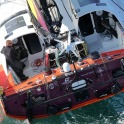

Some things can be fixed at sea and some can not.
Jeremie Beyou learned this the hard way and Alex Thomson got off easy! Catastrophic equipment failure seems to be the story of the last few days. First Sam lost her mast, then Bayou had his hydraulic keel ram snap off where it joins the keel and Alex Thomson damaged his steering system causing him to wipe out. And then there was Marc Guillemot's keel that simply broke off. One can understand that there will be problems after months at sea but we are only 10 days in. What's going on? Below I will attempt to read between the lines of the reports we have been getting from Race HQ and try to make sense of it all.
Despite having teams of people looking after every aspect of the preparation, a Vendee Globe Ocean Race is still an undertaking of mammoth proportions.
I am not a metalurgist or engineer, but it is a statement of fact that the Titanium used in Safran's Keel is a more brittle material that steel. I am sure that this the the first problem his engineers put their minds to. The problem with parts like the keel, with lots of hidden wields, is that it is difficult to detect fatigue whether in a wield or the unwielded portions of the material itself. Ultrasound and x rays can used but these techniques are not infallible and the interpretation of the readings and the application of the testing equipment on unusual shapes is somewhat of an art. I have watched it get done and asked the hard questions. Trust me there is some guess work involved. The other question is was it even done or did they simply rely on the fact that the keel had already done 25,000nm? That many miles is a good fact no doubt, but in fact it really just meant that was just enough miles for the fatigue cycle to be completed. Knowing that the testing of just one part like a keel can cost as much as $25,000 US, I have to wonder if it was even done. It's never easy to sell prevention. If this was the case, I can understand how these decisions get made but it sure seems like a significant mistake in retrospect.
The same goes for Jeremie Beyou's keel ram failure. Titanium keel rams were a big problem in the more powered up Volvo 70's - to the point where several teams in the 2005 race replaced them with steel part way through and willingly accepted the extra weight to ensure reliability. Now apparently the one on Beyou's boat had done many miles and even won the Vendee last time around. Again, was this part tested with ultrasound? Some of these metal parts seem so overbuilt that when you look at them it just seems like it will be the last thing on the boat that fails, but when you think about it, all the forces of the entire boat crashing down from a giant wave with 60 knots of wind in the sails get concentrated right at the head of the keel ram. Its like the "Jesus bolts" on an airplane wing. The size of these parts is probably not so "over size" as they seem. Here is the video showing where it broke. looks king of flimsy. You can see the circle in the middle. Its a different colour because it is covered in grease as that was the inside of the hydraulic tube. The side walls sure look thin to me. The video is taken inside the cabin in the middle of the boat where the top of the keel stick up through the hull and where the hydraulic ram attaches. This is what allows the sailors to swing the keel to windward. Its a small lever to move a 15 foot blade with 10,000 lbs on the tip.
Really not sure what happened to Sam apart from the knock down story. Hard to believe it was quite that simple. These boats get knocked down and pop back up with everything intact all the time. Of course it could have been a strange set of waves that just put too much load on the wrong thing at the moment. My heart goes out to her. Knowing that she was also on a budget, I have to wonder how new her rigging was. It can cost 120,000 US to put new PBO rigging on these boats and it is not uncommon for the rigging to do two times around the world but this is not advisable according to the manufacturers guidelines. It's not like going to sea with freeze dried that is past the "best before" date - its a really big risk. Not saying that was the cause, but it would not be surprising. Sam is on her way back to France with an old Swedish Laser sail as part of her jury rig. Have a look at the photo. Sam is a real survivor. I hope she has a few of those Laser sails and lots of diesel because I don't think that sail will last long. I know we were all looking forward to watching Sam Davies over the next few months as she was the hands down star of the last race with all her terrific video reports and unbelievable positive outlook. If you feel the need to watch Sam in all her glory from the last race in 2008 check out www.sailingaroundtheworld.tv to watch the full length documentary about 2008/2009 Vendee Globe.
And then there is the lucky Alex Thomson. He sure deserves some good luck after having to retire from the last two editions of the Vendee Globe. Thomson snapped a tie-bar that controls the steering. It is a long carbon tube runs horizontally along the transom that joins the tiller, which is in the center of the boat, to the rudders which are mounted off to the side. There are two tie-bars. One for each rudder. According to his own report the bar was broken by wire that attaches the hydro generator to the battery. The hydro generator is a small propeller/generator unit that gets dragged behind the boat to generate power for battery charging. It looks like a small rudder withe propeller on it. It is not new technology but I believe this is the first time it is being used in the Vendee. These devices are not unlike those units we used to have on our bicycles before the advent of the tiny lithium battery. It was a small steel device with a wheel that rubbed on the tire and as you rode your bicycle it would generate enough electricity to light up your bicycle's head light. One a racing boat these devices have not been popular because of the drag they produce and thus the reduction in speed. The technology has improved to the point that the weight saving of carrying less diesel to run the generator more than compensates for the added drag. The only thing that is not accounted for is operator error.
These hydro generators are not deployed all the time. See photo above to see what they look like aboard Energa. When they are it consists of lowering the propeller/ generator unit into the water from the back of the boat. Now I was not there, but it sounds like Thomson made a rookie mistake of deploying the unit out the back without making sure the line was not going to catch on anything. Its like anchoring 101. Don't put the anchor over until you know its not wrapped around your leg or some other piece of deck hardware that will get ripped off. Again, I'm not saying that this could not happen to me, just that it sounds like a careless mistake., But maybe he was just unlucky.
The really fortunate thing is that he was able repair it. I was very impressed with the seamanship skills it must have taken to switch out the broken bar for the one connected to the other rudder. What a terrific design that allows for such quick fixes and kudos to Thomson for thinking of it in the heat of the moment.
Here is the video of Thomson making a repair. The amazing thing is that he admits to never having done anything like this before. All he is doing is splinting the broken tube with carbon and epoxy. Frankly it is pathetic that a yachtsman of his calibre has never done this sort of thing before. To me it sounds like Usain Bolt needing help tying his shoe laces. The reality is that this is how the sport is going. It's a symptom of a world where everyone is a specialist and we use computers to do simple addition and check our spelling. I have to hand it to the guy. It looks like he did a great job, but going to sea for 3 months in a carbon fibre shell without knowing a few basics of working with that material seems unthinkable to me. I remember Roland Jourdain rebuilding the main bulkhead of his boat with carbon battens in the last race without making much fuss and thinking- now there is an old school sailor if there ever was one. Unfortunately his bulkhead repair held but his keel still fell off less than 1000 miles from the finish.
Hang onto your keels - Lots more excitement to come in the next few weeks when the fleet enters the Southern Ocean.
John
